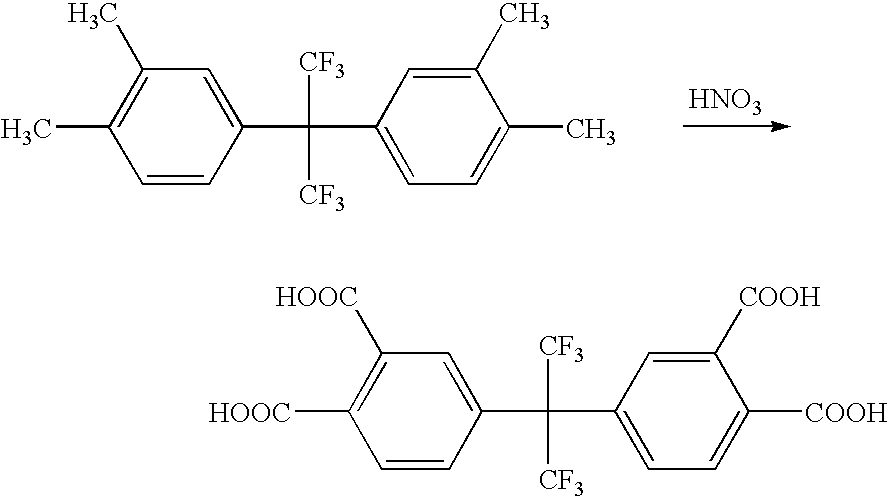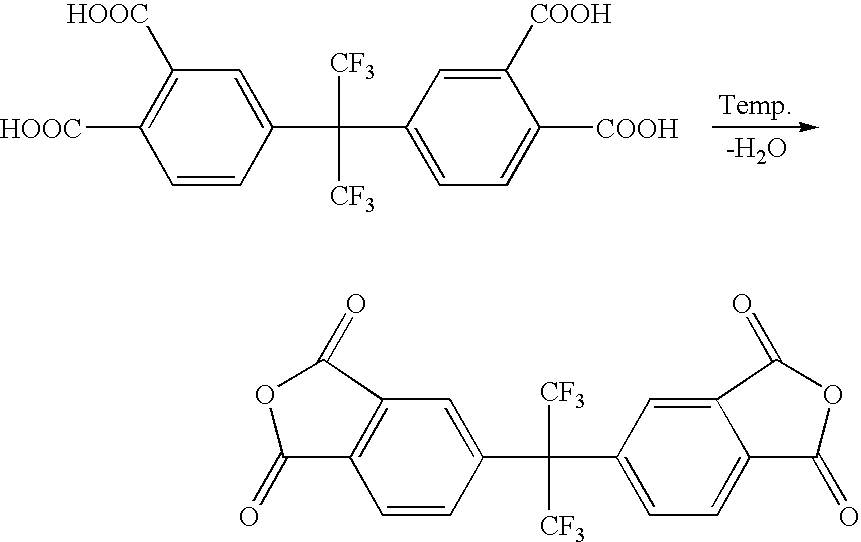Process for making 2,2-bis (3,4-dicarboxyphenyl) hexafluoropropane
a technology of hexafluoropropane and hexafluoropropane, which is applied in the preparation of carboxylic compounds, organic chemistry, chemistry apparatus and processes, etc., can solve the problem of source of undesirable residual metal ions
- Summary
- Abstract
- Description
- Claims
- Application Information
AI Technical Summary
Benefits of technology
Problems solved by technology
Method used
Image
Examples
example 1
[0025]2,2-bis(3,4-dimethylphenyl)hexafluoropropane is oxidized to 2,2-bis(3,4-dicarboxyphenyl)hexafluoropropane. 2,2-bis(3,4-dimethylphenyl)hexafluoropropane and 35% HNO3 are fed into a continuous-flow tubular reactor. The tube diameter is 100 mm and length is 12 m. The temperature of the mixture within the reactor is increased to between 200° C. and 240° C. The volumetric flow in the reactor is set to 5.9 liters / minute. Nitric oxides are formed as a reaction by-product and are recycled to form HNO3. The effluent from the reactor is collected, depressurized, and cooled to room temperature. HNO3 is removed from the effluent. The desired product 2,2-bis(3,4-dicarboxyphenyl)hexafluoropropane precipitates within the effluent and is separated by centrifugation and washed with water. The purity of the product is 97% 2,2-bis(3,4-dicarboxyphenyl)hexafluoropropane as determined by high pressure liquid chromatography (HPLC).
example 2
[0026]A volume flow of 100 ml / h of a mixture of 20 ml / h 2,2-bis(3,4-dimethylphenyl)hexafluoropropane and 70 ml / h 35% aqueous HNO3 are fed into a microreactor. The micro reactor has of a micro mixer at the inlet having a typical diameter of about 2 mm and a volume of about 12 ml. The reaction pressure is controlled by a pressure control valve. The residence time part is divided into different sections (typically up to 4), which have a further feeding point with a consequent mixer for additionally fed HNO3. Furthermore, each section can be heated individually to control the temperature profile over the residence time. The temperature along the residence time was 210° C., the pressure was about 19,000 hPa. In this example, no further HNO3 was added in the feeding points. The reaction mixture is pumped through the reactor with a residence time of about 7 minutes leading to complete conversion and a selectivity of about 97%. The outflow of the reactor is depressurized and cooled to room ...
PUM
| Property | Measurement | Unit |
|---|---|---|
| Temperature | aaaaa | aaaaa |
| Temperature | aaaaa | aaaaa |
| Temperature | aaaaa | aaaaa |
Abstract
Description
Claims
Application Information
 Login to View More
Login to View More - R&D
- Intellectual Property
- Life Sciences
- Materials
- Tech Scout
- Unparalleled Data Quality
- Higher Quality Content
- 60% Fewer Hallucinations
Browse by: Latest US Patents, China's latest patents, Technical Efficacy Thesaurus, Application Domain, Technology Topic, Popular Technical Reports.
© 2025 PatSnap. All rights reserved.Legal|Privacy policy|Modern Slavery Act Transparency Statement|Sitemap|About US| Contact US: help@patsnap.com


